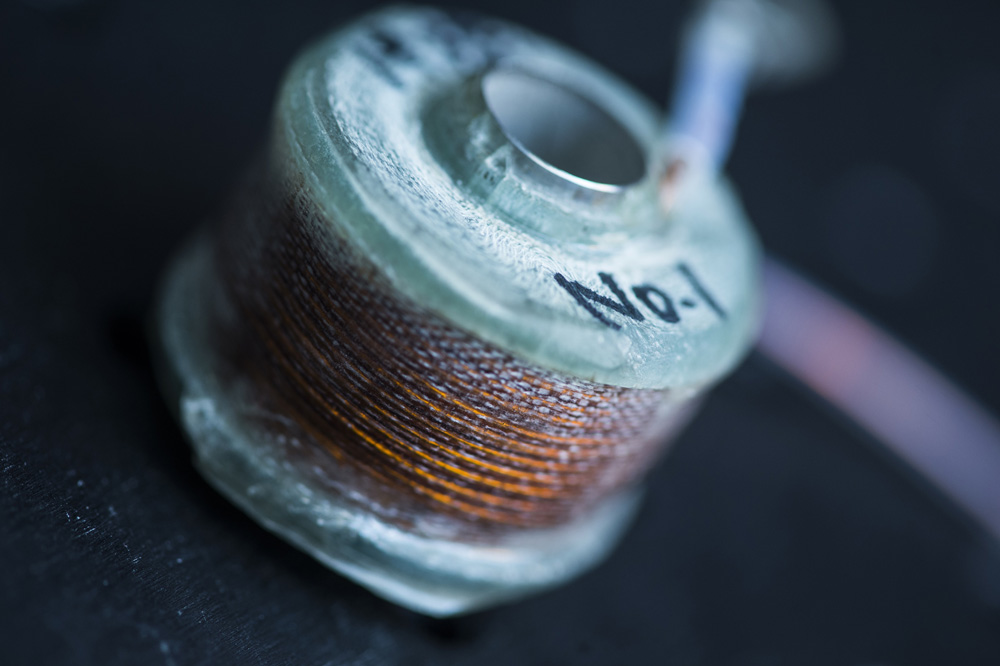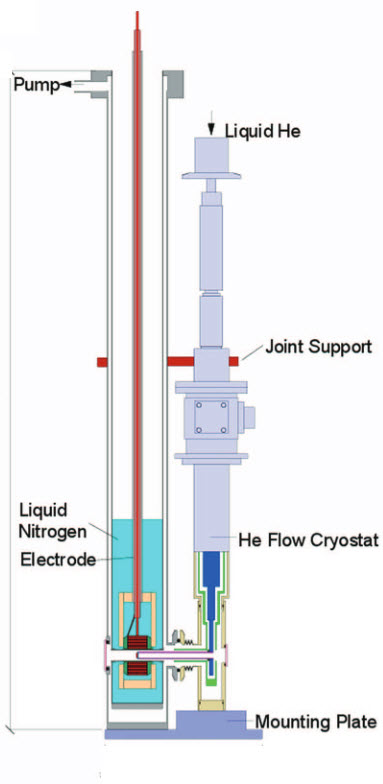RAMBO: a small but powerful magnet
January 8, 2014

A palm-sized coil is the heart of RAMBO, a Rice-built tabletop system to expose experiments to high magnetic fields. The coil developed by Hiroyuki Nojiri at Tohoku University in Japan provides a pulsed field of up to 30 tesla and allows for the collection of data at close range. (Credit: Jeff Fitlow/Rice University)
RAMBO (Rice Advanced Magnet with Broadband Optics) — a tabletop magnetic pulse generator that does the work of a room-sized machine — has been developed by Rice University scientists.
The device will allow researchers who visit the university to run spectroscopy-based experiments on materials in pulsed magnetic fields of up to 30 tesla. (A typical high-resolution magnetic resonance imaging system used in hospitals is in the 0.5-tesla to 3.0-tesla range in strength.)
The Rice lab of physicist Junichiro Kono created RAMBO in collaboration with Hiroyuki Nojiri at the Institute for Materials Research at Tohoku University in Sendai, Japan.
Aside from its size and powerful performance, RAMBO has windows that allow researchers to directly send a laser beam to the sample and collect data at close range, instead of via an optical fiber.
“RAMBO finally gives us the ability to combine ultrastrong magnetic fields and very short and intense optical pulses; it’s a combination of two extreme conditions,” said Kono.
How it works

Schematic diagram demonstrating the coupled cryostats and the various components of the RAMBO magnet system (credit: G. Timothy Noe II et al./Review of Scientific Instruments)
RAMBO is possible, Kono said, because of Nojiri’s development of a small and light mini-coil electromagnet*. A little bigger than a spool of thread, the magnet allows Rice researchers to perform on campus many of the experiments they once carried out at the National High Magnetic Field Laboratory at Florida State University or at Los Alamos National Laboratory.
The Florida State facility has produced continuous magnetic fields of 45 tesla; Los Alamos has produced pulses over 100 tesla.
“I would say we’ve been able to do 80 percent of the experiments here that we used to have to do elsewhere,” Kono said. “And that’s not all. There are things that only we can do here. This is a unique system that doesn’t exist anywhere else in the world.
“High magnetic fields have been around for many years. Ultrafast spectroscopy has been around for many years. But this is the first combination of the two,” he said.
Kono’s group built the system to analyze very small or microscopic samples. A sample plate sits on a long sapphire cylinder that passes through the coil’s container and juts through one end of the magnet to place it directly in the center of the magnetic field.
The cylinder provides one direct window to the experiment; a port on the other side of the container looks directly down upon the sample. The coil is bathed in liquid nitrogen to keep it cool at around 80 kelvin (-315 degrees Fahrenheit). The sample temperature can be independently controlled from about 10 K to room temperature by adjusting the flow of liquid helium to the sapphire cylinder.
Researchers can now collect real-time, high-resolution data in a system that couples high magnetic fields and low temperatures with direct optical access to the magnet’s core, Kono said. The unit can also run a new experiment in a 30-tesla field every 10 minutes (or less for smaller peak fields), as opposed to waiting the hours often required for field generators to cool down after each experiment at large laboratories.
Kono’s group is now using RAMBO in studies of superfluorescence by hitting materials with femtosecond laser pulses to trigger quantum effects. It allows the laser pulse, the magnetic field pulse and the spectrometer to work in sync.
The team has already collaborated with Jean Léotin, a co-author of the paper and a professor at the Laboratoire National des Champs Magnétiques Intenses in Toulouse, France, to perform one of the first time-domain terahertz spectroscopy experiments in high magnetic fields.
The National Science Foundation, the Department of Energy and the Robert A. Welch Foundation supported the research.
* According to the Review of Scientific Instruments paper: “The magnetic field pulse profile resembles a half sine wave with exponential decay with a full width at half maximum of 4–5 ms, which is close to π√LC. After discharging the stored energy of the capacitor bank into the coil, we must wait minutes, depending on the peak magnetic field strength, for the coil to cool back down to liquid nitrogen temperature before firing another magnet shot. … The magnet coil is made from rectangular wire, with a cross-sectional area of 1 × 1.5 mm. made of a 50%–50% alloy of silver and copper. The coil contains 14–15 turns per layer on average and 13 layers, making a length of ∼ 22.5 mm with inner diameter of 14 mm and outer diameter of 43 mm.. It has an inductance of 408 μH. It is connected to a capacitor bank with capacitance of 5.6 mF, which can store nd deliver over 9 kJ of energy into the coil to generate a maximum peak magnetic field of 30 T using a peak current of almost 5.1 kA when the bank is charged up to∼1.8 kV.”
Abstract of Review of Scientific Instruments paper
We have developed a mini-coil pulsed magnet system with direct optical access, ideally suited for nonlinear and ultrafast spectroscopy studies of materials in high magnetic fields up to 30 T. The apparatus consists of a small coil in a liquid nitrogen cryostat coupled with a helium flow cryostat to provide sample temperatures down to below 10 K. Direct optical access to the sample is achieved with the use of easily interchangeable windows separated by a short distance of ∼135 mm on either side of the coupled cryostats with numerical apertures of 0.20 and 0.03 for measurements employing the Faraday geometry. As a demonstration, we performed time-resolved and time-integrated photoluminescence measurements as well as transmission measurements on InGaAs quantum wells.